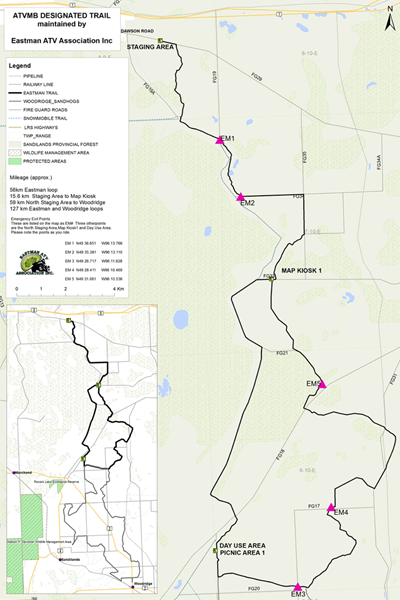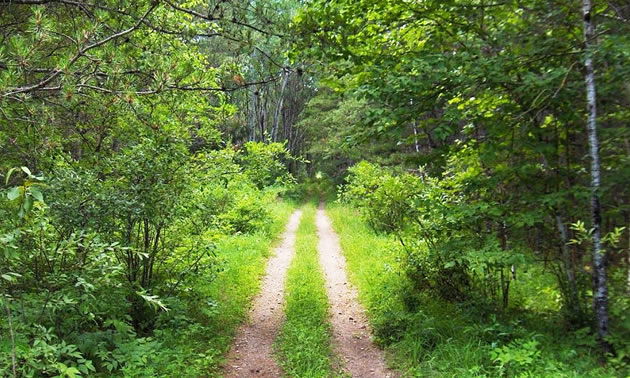Two years ago, the Eastman ATV Association opened its trail in the heart of the Sandilands Provincial Forest.
The forest’s sand-based terrain grows all different kinds of vegetation, from shrubs all the way to tall pines. Association president David Lee said it’s a very attractive area to ride an ATV.
“There’s a lot of tight, twisty trails. Sand-based with some gravel, some interesting trails with a little bit of water on them, and it also ends up into a tight-packed trail with a clay base,” Lee said. “You’ve got a good variety of trails to ride out there.”
A popular site for ORVS
Lee said Sandilands has been popular with young riders for nearly 20 years, which pushed his group to see the area developed for ATVs.
“Due to the number of youth with ATVs in the area, there was a need to develop a designated trail system and the beginning of this started in 2009,” Lee said. “A group got together and the Eastman ATV Trail was getting redeveloped. Our vision back then was to have a designated trail on Crown land.”
Two years ago, that vision became a reality through the support of Manitoba Sustainable Development and other stakeholders.
“We were successful in securing one of the first trails on Crown land in Manitoba. There were other trails in the area before ours, but they were on rural municipality trails. They weren’t on Crown land,” Lee said. “So our trail and the Sandhogs Trail were the first to be developed on Crown land in the province of Manitoba.”

Members of the Eastman ATV Association cutting the ribbon at the grand opening of the Eastman ATV Trail in Sandilands Provincial Forest.
— Photo courtesy of Eastman ATV Association.
Looking back, Lee was amazed with the amount of work they put into getting the trail recognized by the Province.
“We never had a designated trail. Before, you weren’t allowed to maintain your trail. You could have the wheel touch the ground, but you weren’t allowed to cut a tree, move it off the path; you weren’t allowed to do any landscaping or change the ground which you ride on,” Lee said. “As a designated trail, we are able to maintain these trails and build them up to a safer standard, and one thing this has really developed is tourism. Now you got an area you can promote to tourist traffic.”
What tourists can expect
Lee feels any rider wanting to check out the trail network needs to come prepared by visiting the Eastman ATV Association’s website first.
“We strongly urge people to download the map because it is a trail and it is the responsibility of the rider to know where they are at all times,” Lee said. “The sign will show you around the trail but you need your map.”

Map of the Eastman ATV Trail from ATV Manitoba.
— Photo courtesy of Eastman ATV Association.
Lee said there is a huge amount of land to cover in the Sandilands Provincial Forest, both on the Eastman ATV trail and the nearby Sandhog trail.
“Between the two clubs, you are looking at 180 kilometres of trail, so it’s a really good day ride,” Lee said. “You can ride our trail system which is approximately 90 kilometres. It’s set up in a loop, so you loop on out.”
Lee also encourages you to check out the trail managed by the Woodridge ATV Sandhogs.
“On the back end of our trail, there’s another trail system managed by the Sandhogs and that trail will take you into Woodridge,” he said.
Woodridge is a small community built on the pulp and lumber industry in the 1900s. It’s also an ATV- friendly community.
“Woodridge has an ATV-friendly campground—you can take your ATV right up to the community store and buy fuel. There’s a great restaurant,” Lee said. “There’s a little hamlet where you can rent a room, so if you don’t have a camper, there are facilities available to stay overnight.”
What stands out on the Eastman ATV Trail?
Lee said there’s a lookout that can be found around the halfway point of the trail that dates back to ancient history.
“People can find a trail that will lead them to a ridge. It’ll look out to the north and you will be up higher than the rest of the area,” Lee said. “This is actually the shores of Lake Agassiz (from) back in the Ice Age. So there’s some historic value there that you are looking at ancient shores of an old lake.”
Lee added their trail network also contains a portion of the old Dawson Trail.
“It was a historic trail back in the time of the settlers, so you could actually travel through history,” Lee said. “There are remnants of an old corduroy road. You’ll see logs sticking up sideways and sticking on the ground. Settlers of our country travelled on this exact trail we are riding on today.”
For people willing to explore, Lee said you can find plenty off the beaten path.
“Another highlight is an old trappers shack. We call it the Red Roof Trappers Shack and it’s just a little bit off our trail,” Lee said. “It was a trapper’s destination point and there were people trapping out of there making a living.”
You can find a map of the Eastman ATV trail at https://eastmanatv.com/. You can also visit http://woodridgesandhogs.ca/sandhogs-trail-map-2016/ for a map of the nearby Sandhog trail.











